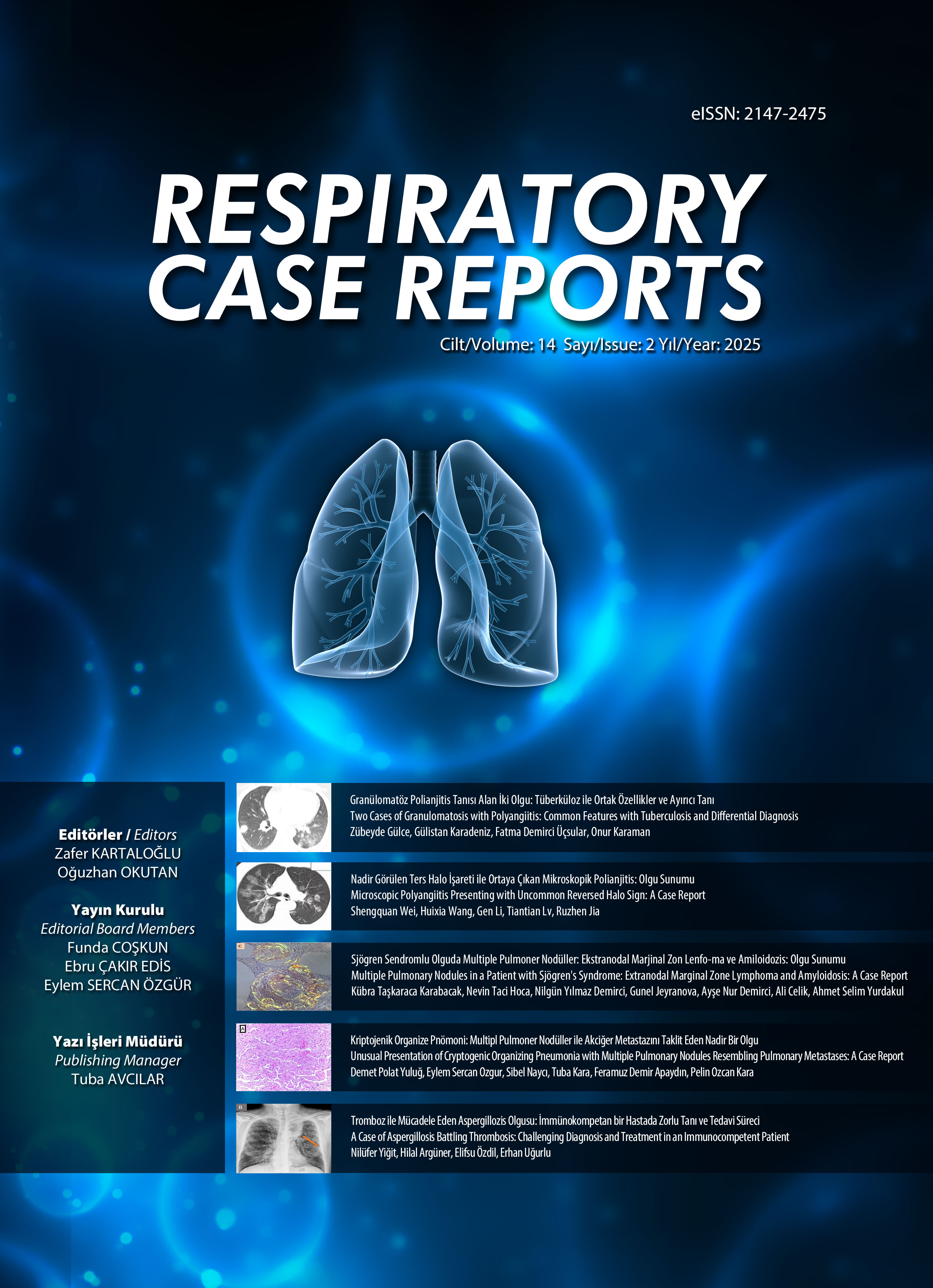e-ISSN 2147-2475

Volume: 3 Issue: 2 - June 2014
| COVER | |
| 1. | Cover Page I |
| EDITORIAL BOARD | |
| 2. | Editorial Board Page II |
| CASE REPORT | |
| 3. | Hypersensitivity pneumonitis due to glue inhalation Ebru Ünsal, Sema Canbakan, Ruhsar Ofluoğlu, Arzu Ertürk, Nermin Çapan, Müjgan Güler doi: 10.5505/respircase.2014.97268 Pages 86 - 89 A 31-year-old male patient was admitted to the hospital with coughing and dyspnea. One month ago he was treated with inhaler drugs with the diagnosis of occupational asthma. His history revealed that he smoked five packets of cigarettes per year (he was an ex-smoker for 8 years) and worked in the furniture industry for 3 years. He also added that he was exposed to glue inhalation in the work place; he did not use a mask. The physical examination revealed normal vital signs, and oxygen saturation was 95%. Rales in the base of right lung were also noted. Diffusion capacity was found to be very low. The thoracic CT revealed ground-glass densities in the right lower lobe and air trapping in the left lung. Fiber optic bronchoscopy and transbronchial biopsy were performed. The transbronchial biopsy specimen was insufficient for a specific diagnosis. Right thoracotomy and wedge resection were performed for the specific diagnosis. The pathological diagnosis was reported to be hypersensitivity pneumonitis (HP). The patient was treated with methylprednisolone (1mg/kg/day) for six months. After the treatment and removal from the antigen exposure, clinical and radiological improvements were obtained. In conclusion, detailed working anamnesis is important in the patients with suspicion of occupational HP. |
| 4. | INTERACTIVE CASE REPORT: The Importance of Bone Scintigraphy in the Diagnosis of Pulmonary Alveolar Microlithiasis Umut Elboga, Ebuzer Kalender, Öner Dikensoy, Hasan Deniz Demir, Zeki Çelen, Mustafa Yılmaz doi: 10.5505/respircase.2014.93063 Pages 90 - 92 Pulmonary alveolar microlithiasis (PAM) is a rare chronic lung disease characterized by the deposition of intra-alveolar microliths in both lungs. Although diagnosis is usually based on specific radiological findings, pathological examination may be necessary for final diagnosis. Bone scintigraphy is another imaging method that aids in the diagnosis. Diffuse Tc-99m methylene diphosphonate (MDP) uptake was reported in the lungs on bone scintigraphy in many cases. The current study presents a case diagnosed with PAM who had diffuse increased Tc-99m MDP uptake in both lungs on bone scintigraphy. |
| 5. | INTERACTIVE CASE REPORT: A Case of Pulmonary Langerhans Cell Histiocytosis Yelda Varol, Pınar Çimen, Nuran Katgı, Mehmet Ünlü, İsmail Kayaalp, Ahmet Üçvet, Sülün Ermete, Salih Zeki Güçlü doi: 10.5505/respircase.2014.74745 Pages 93 - 96 Pulmonary Langerhans cell histiocytosis is a rare idiopathic disorder mostly seen in young adult smokers. A 36-year-old female patient referred to our clinic with the complaints of cough and sputum production for the last four months. She had a smoking history of 7 packets per year (current smoker). In high resolution computed tomography, cystic appearances, which were more marked in upper lobes, ground glass opacities near the cystic lesions, and millimetric nodules around them were observed. A surgical biopsy showed a lymphocytic lung infiltrate with Langerhans cells immune staining with CD1a antigen positivity. |
| 6. | Pulmonary Alveolar Microlithiasis İpek Özmen, Hamza Ogun, Elif Yıldırım, Aslıhan Ak, Haluk Çalışır doi: 10.5505/respircase.2014.47965 Pages 97 - 100 Pulmonary alveolar microlithiasis (PAM) is a rare lung disease characterized by the deposition of calcium in the alveolar spaces and bilateral diffuse micronodular sandstorm radiographic pattern. The current report presents the case of a 48-year-old woman with pulmonary alveolar microlithiasis. The patient presented with exertional dyspnea for the past five years. The physical examination was within normal limits and respiratory sounds were normal. The chest x-ray revealed a bilateral diffuse micronodular pattern in the middle and the lower areas of both lungs. On the parenchymal window of thorax computed tomography (CT), bilateral diffuse widespread millimetric calcified nodules that were more prominent in the lower lobes were observed. Whole body bone scintigraphy with technetium-99m revealed bilateral, diffuse, heterogeneous, increased uptake in the pulmonary parenchyma. Regarding the current special radiological findings, further invasive diagnostic examination was not performed, the patient was diagnosed with PAM and continues to be followed-up on without treatment. |
| 7. | A Rare Cause of Chronic Cough: Plastic Bronchitis Mehmet Bayram, Isa Döngel, Muhammed Emin Akkoyunlu, Levent Kart doi: 10.5505/respircase.2014.30502 Pages 101 - 103 Plastic bronchitis is a rare disease characterized by chronic cough, dyspnea, airway obstruction, and expectorating rubber-like secretions. This entity is mostly seen in children predominantly in association with an underlying congenital heart disease. We present an adult case who was treated for asthma for two years and finally diagnosed with plastic bronchitis via bronchoscopy. |
| 8. | VATS for Bilateral Syncronized Spontaneous Pneumothorax Cumhur Murat TULAY, Mert Aygün doi: 10.5505/respircase.2014.24633 Pages 104 - 106 Bilateral spontaneous pneumothorax is an extremely rare condition. The current study presents a primary synchronized bilateral spontaneous pneumothorax patient who was operated on by VATS in a semi-seated position with single lumen intubation and bilaterally, simultaneously. |
| 9. | Ruptured Lung Hydatid Cyst in Late Pregnancy that Mimics Tension Hydropneumothorax Cumhur Murat TULAY, Ahmet Ceylan doi: 10.5505/respircase.2014.00719 Pages 107 - 109 Respiratory failure and hemodynamic instability are responsible for up to 80% of the obstetric admissions to the intensive care unit. We report an unusual case of a multigravida with ruptured pulmonary hydatid cyst that mimics tension hydropneumothorax. |
| 10. | Treatment of Lung Abscess by Ultrasonography Guided Fine Needle Aspiration Aziz Gümüş, Servet Kayhan, Halit Çınarka, Ayşe Ertürk, Asiye Yavuz, Ünal Şahin doi: 10.5505/respircase.2014.77698 Pages 110 - 113 Lung abscess is a well-circumscribed and localized suppurative lesion in the lung parenchyma as a result of pyogenic microorganisms, which usually leads to tissue necrosis and cavitation. The lung abscess radiologically appears as an air-fluid level and despite the antibiotic treatments, up to 10%-15% of these lesions do not heal. In these cases, drainage by the transthoracic catheters and aspiration by the guidance of bronchoscopy or computed tomography and surgical resection are the choices of treatment modalities. Herein, we report a 70-year-old female patient with diabetes mellitus. A lung abscess was detected in the right lower lobe with peripheral localization. The patient did not recover by medical therapy and the content of abscess was aspirated by ultrasonography guidance. No cases with lung abscess that was treated completely with the fine needle aspiration by the guidance of ultrasonography were found in the literature. As a result, we recommend that transthoracic drainage of peripheral lung abscesses by the guidance of ultrasonography should be considered as a first choice treatment modality with the advantages of being affordable, convenient, and with no exposure to radiation. |
| 11. | Generalized Keratosis Lichenoides Chronica Induced By Antituberculosis Therapy: A Case Report İlkin Zindancı, Hacer Kuzu Okur, Ebru Zemheri, Burce Can, Zafer Turkoglu, Mukaddes Kavala, Ozge Akbulak, Filiz Topaloglu doi: 10.5505/respircase.2014.58569 Pages 114 - 117 Keratosis lichenoides chronica (KLC) is a rare and chronic skin disease characterized by erythema, keratotic and lichenoid papules are distributed symmetrically. The histological examination of KLC reveals lichenoid dermatitis with hyper and parakeratosis. Although the etiology and pathogenesis of KLC are unknown, it is suggested that KLC is a variant of lichen planus or lichenoid drug eruptions. We present a case of generalized KLC that occurred during antituberculosis therapy including isoniazid, rifampicin, ethambutol, and pyrazinamide and dramatically improved after cessation of therapy. We report this generalized KLC case in order to draw attention to the side effects that can be seen during tuberculosis treatment. |
| 12. | A Rare Clinical Entity of Lung Cancer: Metastatic Peripheral Arterial Embolism Halit Çınarka, Servet Kayhan, Aziz Gümüş, Aysel Kurt, Hasan Türüt, Gökhan İlhan, Recep Bedir, Ünal Şahin doi: 10.5505/respircase.2014.44366 Pages 118 - 121 Lung cancers rarely metastasize to intracardiac ventricular wall and subsequently embolizes to systemic circulation, causing arterial occlusion. The current study reports a case of lung cancer with peripheral arterial embolism. This is unique case report because the first diagnostic tool of bronchogenic carcinoma was embolectomy material during hospitalization and the initial evaluation stage of the patient. Tumor embolization should be considered in the differential diagnosis in an abrupt cessation of peripheral arterial circulation. |
| 13. | Right Aortic Arch Anomaly Masqurading As Bronchial Asthma Burcu Karaboğa, Ahmet Gökhan Arslan, Aykut Çilli doi: 10.5505/respircase.2014.14632 Pages 122 - 125 Right aortic arch is a rare condition that is usually asymptomatic in adulthood. Patients may present with dyspnea and dysphagia. This report presents a 59-year-old woman with a right aortic arch anomaly who had been followed-up with asthma for many years. The current report emphasizes the importance of the consideration of aortic arch anomaly in the differential diagnosis of asthma. |
| 14. | INTERACTIVE CASE REPORT: Hypersensitivity Pneumonitis Caused by Pigeon Contact Pınar Yıldız Gülhan, Aydanur Ekici, Ömür Güngör, Emel Bulcun, Mehmet Ekici doi: 10.5505/respircase.2014.21043 Pages 126 - 129 Hypersensitivity pneumonitis (HP) is a non-IgE-mediated hypersensitivity reaction which is caused by repeated inhalation of allergens in the patient has been previously sensitized. The most important point in the diagnosis is to consider HP and to profoundly question the environmental and occupational exposure. A 54-year-old, female suffering from shortness of breath, fatigue, myalgia for two years admitted to our hospital. Fine crackles were auscultated. Reticular and micronodular opacities were observed at chest X-ray. Diffusion capacity of the patient was low. High resolution computed tomography revealed ground glass opacities, interlobular septal thickening, and mosaic attenuation areas in the lung field. As the patient had contact history with pigeon she was diagnosed with HP. With proper treatment and removal of influential factors, such findings of regression were observed. The current case is presented due to its rarity. |
| 15. | Mounier-Kuhn syndrome: A rare cause of recurrent respiratory tract infections Esra Ertan, Nihal Geniş, İlyas Kocabağ, Veysel Yılmaz, Mehmet Tutar doi: 10.5505/respircase.2014.46220 Pages 130 - 133 Mounier-Kuhn syndrome is a rare syndrome characterized by tracheobronchomegaly resulting from the loss or atrophy of musculo-elastic fibers within the trachea and main bronchi wall. This syndrome is more common in the third or fourth decades of life. The diagnosis can usually be made by measuring the diameters of trachea and main bronchi radiologically. A 52-year-old male patient was referred to our outpatient clinic with chronic productive cough and recurrent respiratory tract infections. We detected tracheobronchomegaly, tracheal diverticula, and bronchiectasis in the chest CT scans. This rare case is presented due to later onset than expected and very demonstrative radiological findings. |











